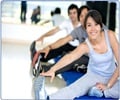Physicians have explored whether tai chi, balance programs and fitness routines can help decrease the likelihood that older adults will fall and injure themselves.
Physicians and physical therapists in recent years have explored whether tai chi, balance programs and fitness routines can help decrease the likelihood that older adults will fall and injure themselves. Many of these programs have shown promise, but their relative value is still open to debate.
Now, a study from researchers at the University of Michigan Health System and the Veterans Affairs Ann Arbor Healthcare System suggests that a program focusing on increasing step length and speed is more effective at improving mobility and balance than tai chi. While tai chi – a Chinese martial art form consisting of slow, rotational movements and weight-shifting – offers many benefits, the researchers say, they’re not as great as those produced by a balance-training program.“Our results indicate that in older adults with at least mild balance impairment, Combined Balance and Stepping Training (CBST) results in modestly greater improvement in balance, stepping and functional mobility compared to tai chi training,” says senior author Neil B. Alexander, M.D., professor in the Division of Geriatric Medicine, Department of Internal Medicine, at the U-M Health System, and acting director of the Geriatric Research, Education, and Clinical Center, VA Ann Arbor Healthcare System.
“What this tells us is that if you want to improve your ability to balance and walk, try a program that focuses on improving balance while moving and the ability to step quickly and further,” he says of the study, which appears in the new edition of the Journal of the American Geriatrics Society. “Data from this study can help determine which balance training program may be most optimal to improve balance and eventually reduce falls. Among older adults, falls are becoming an increasing problem, so it is important that we find ways to help prevent them in the first place.”
This is the first comparison of two balance training programs in which each type of program has been proven to reduce falls, notes lead author Joseph O. Nnodim, M.D., Ph.D., clinical instructor in the Division of Geriatric Medicine at the U-M Health System and a research scientist at the VA Ann Arbor GRECC.
The researchers add that the CBST program requires no specialized equipment or advanced training for the instructor. “It’s a very easy program to implement,” says Alexander, director of the Mobility Research Center at the U-M Geriatrics Center.
The study lasted 10 weeks, and participants did three one-hour sessions a week with an instructor. Of the 162 people in the study, 81 were in the CBST group and 81 were in the Tai Chi classes. All were ages 65 and older.
Advertisement
After initial testing, the participants were assigned to one of the two fall-prevention training options. The CBST classes included activities in which participants moved their upper bodies while bouncing and catching a ball; increasing the complexity of ambulatory tasks, such as changing direction to walk forward or laterally; walking on a plank; turning, bending and stepping on and off curbs; stepping over obstacles; and more. The tai chi classes focused on body alignment; weight shifts, including standing on one leg; hip and ankle rotations; stepping motions backward, forward and laterally; and more. Emphasis was on awareness of one’s body alignment, relaxation and distribution of weight, and 12 sequences from the tai chi Yang Short Form were practiced.
Advertisement
“This research is very promising in our efforts toward reducing falls among older adults,” Nnodim says. “We would like future research to include a comparison of fall rates in response to these two programs so we can develop an even better sense of what works best in the prevention of falls.”
Source-Newswise
SRM






